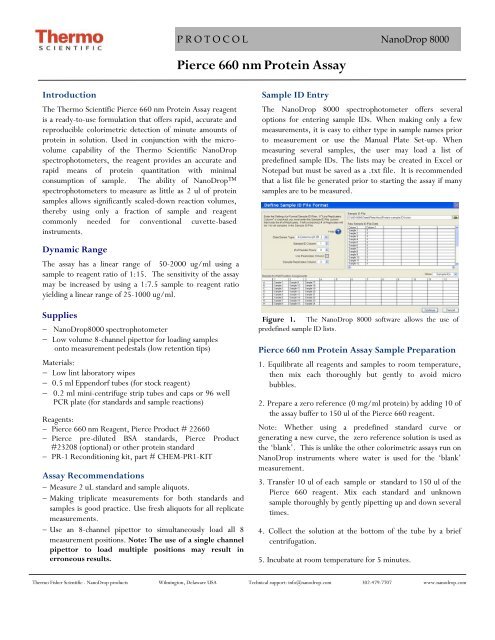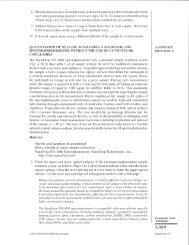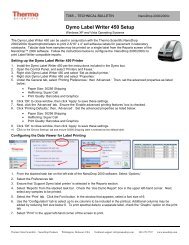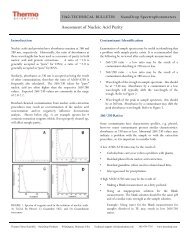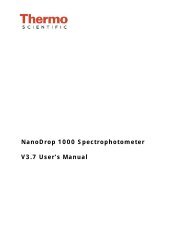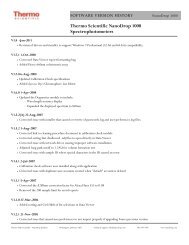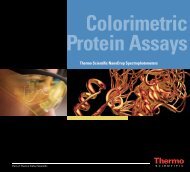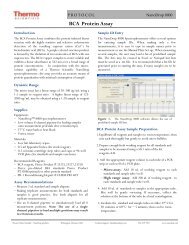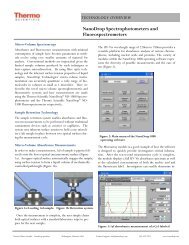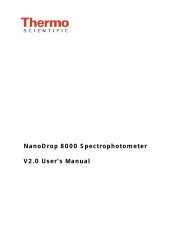Pierce 660 nm Protein Assay - NanoDrop
Pierce 660 nm Protein Assay - NanoDrop
Pierce 660 nm Protein Assay - NanoDrop
Create successful ePaper yourself
Turn your PDF publications into a flip-book with our unique Google optimized e-Paper software.
PROTOCOL <strong>NanoDrop</strong> 8000<br />
<strong>Pierce</strong> <strong>660</strong> <strong>nm</strong> <strong>Protein</strong> <strong>Assay</strong><br />
Introduction<br />
The Thermo Scientific <strong>Pierce</strong> <strong>660</strong> <strong>nm</strong> <strong>Protein</strong> <strong>Assay</strong> reagent<br />
is a ready-to-use formulation that offers rapid, accurate and<br />
reproducible colorimetric detection of minute amounts of<br />
protein in solution. Used in conjunction with the microvolume<br />
capability of the Thermo Scientific <strong>NanoDrop</strong><br />
spectrophotometers, the reagent provides an accurate and<br />
rapid means of protein quantitation with minimal<br />
consumption of sample. The ability of <strong>NanoDrop</strong><br />
spectrophotometers to measure as little as 2 ul of protein<br />
samples allows significantly scaled-down reaction volumes,<br />
thereby using only a fraction of sample and reagent<br />
commonly needed for conventional cuvette-based<br />
instruments.<br />
Sample ID Entry<br />
The <strong>NanoDrop</strong> 8000 spectrophotometer offers several<br />
options for entering sample IDs. When making only a few<br />
measurements, it is easy to either type in sample names prior<br />
to measurement or use the Manual Plate Set-up. When<br />
measuring several samples, the user may load a list of<br />
predefined sample IDs. The lists may be created in Excel or<br />
Notepad but must be saved as a .txt file. It is recommended<br />
that a list file be generated prior to starting the assay if many<br />
samples are to be measured.<br />
Dynamic Range<br />
The assay has a linear range of 50-2000 ug/ml using a<br />
sample to reagent ratio of 1:15. The sensitivity of the assay<br />
may be increased by using a 1:7.5 sample to reagent ratio<br />
yielding a linear range of 25-1000 ug/ml.<br />
Supplies<br />
− <strong>NanoDrop</strong>8000 spectrophotometer<br />
− Low volume 8-channel pipettor for loading samples<br />
onto measurement pedestals (low retention tips)<br />
Materials:<br />
− Low lint laboratory wipes<br />
− 0.5 ml Eppendorf tubes (for stock reagent)<br />
− 0.2 ml mini-centrifuge strip tubes and caps or 96 well<br />
PCR plate (for standards and sample reactions)<br />
Reagents:<br />
− <strong>Pierce</strong> <strong>660</strong> <strong>nm</strong> Reagent, <strong>Pierce</strong> Product # 22<strong>660</strong><br />
− <strong>Pierce</strong> pre-diluted BSA standards, <strong>Pierce</strong> Product<br />
#23208 (optional) or other protein standard<br />
− PR-1 Reconditioning kit, part # CHEM-PR1-KIT<br />
<strong>Assay</strong> Recommendations<br />
− Measure 2 uL standard and sample aliquots.<br />
− Making triplicate measurements for both standards and<br />
samples is good practice. Use fresh aliquots for all replicate<br />
measurements.<br />
− Use an 8-channel pipettor to simultaneously load all 8<br />
measurement positions. Note: The use of a single channel<br />
pipettor to load multiple positions may result in<br />
erroneous results.<br />
Figure 1. The <strong>NanoDrop</strong> 8000 software allows the use of<br />
predefined sample ID lists.<br />
<strong>Pierce</strong> <strong>660</strong> <strong>nm</strong> <strong>Protein</strong> <strong>Assay</strong> Sample Preparation<br />
1. Equilibrate all reagents and samples to room temperature,<br />
then mix each thoroughly but gently to avoid micro<br />
bubbles.<br />
2. Prepare a zero reference (0 mg/ml protein) by adding 10 of<br />
the assay buffer to 150 ul of the <strong>Pierce</strong> <strong>660</strong> reagent.<br />
Note: Whether using a predefined standard curve or<br />
generating a new curve, the zero reference solution is used as<br />
the ‘blank’. This is unlike the other colorimetric assays run on<br />
<strong>NanoDrop</strong> instruments where water is used for the ‘blank’<br />
measurement.<br />
3. Transfer 10 ul of each sample or standard to 150 ul of the<br />
<strong>Pierce</strong> <strong>660</strong> reagent. Mix each standard and unknown<br />
sample thoroughly by gently pipetting up and down several<br />
times.<br />
4. Collect the solution at the bottom of the tube by a brief<br />
centrifugation.<br />
5. Incubate at room temperature for 5 minutes.<br />
Thermo Fisher Scientific - <strong>NanoDrop</strong> products Wilmington, Delaware USA Technical support: info@nanodrop.com 302-479-7707 www.nanodrop.com
2<br />
PROTOCOL <strong>NanoDrop</strong> 8000<br />
Protocol<br />
1. Clean pedestals by pipetting 2 uL of dH 2 O onto each all 8<br />
lower pedestals, and then lowering the arm so that the water<br />
makes contact with both the upper and lower measurement<br />
surfaces. Raise the arm and wipe all pedestals with a dry laboratory<br />
wipe.<br />
2. Launch the <strong>NanoDrop</strong> 8000 software and open the <strong>Pierce</strong> <strong>660</strong><br />
<strong>nm</strong> module.<br />
3. Initialize the instrument by loading 2 uL of dH 2 O to all 8 lower<br />
pedestals, lower the arm and click OK. When initialization is<br />
complete, use a dry laboratory wipe to wipe the water from all<br />
measurement surfaces.<br />
4 From the Standards Choose Source window select the<br />
standard curve source. It is recommended that new standard<br />
absorbance values be measured each time the assay is run.<br />
Manually enter standard concentration values or enter a concentration<br />
series using a previously stored standard curve. If<br />
using a preloaded standard curve, continue to step 7.<br />
8. Gently mix the samples and use an 8-channel pipettor to<br />
simultaneously load multiple pedestal positions. Use fresh<br />
2 uL aliquots for each replicate.<br />
9. After completing all the measurements, re-condition the<br />
pedestals with PR-1.<br />
Performance Data<br />
BSA<br />
(ug/ml) A<strong>660</strong> (n=5) St dev %CV<br />
0 0 NA NA<br />
125 .016 .001 6.25<br />
250 .030 .001 3.33<br />
500 .062 .001 1.61<br />
750 .088 .002 2.27<br />
1000 .110 .002 1.81<br />
1500 .165 .001 .606<br />
2000 .196 .002 1.02<br />
Table 1. Typical performance data for the 15:1 reagent to<br />
sample ratio protein assay using a BSA Standard Curve.<br />
Typical <strong>Pierce</strong> <strong>660</strong> <strong>nm</strong> Sample Spectrum<br />
Figure 2. The <strong>NanoDrop</strong> 8000 software allows the use of a predefined<br />
standard curve or the user may build a new curve.<br />
5. Use an 8-channel pipettor to transfer 2 uL of dH20 onto each<br />
of the 8 lower pedestals. Lower the arm and click Blank.<br />
When the measurement is complete wipe the pedestals with a<br />
lab wipe.<br />
6. Gently mix the standards, then use a 8-channel pipettor to<br />
simultaneously load the reference (reagent and buffer, no protein)<br />
and standards to generate a new standard curve. Use<br />
fresh 2 uL aliquots to measure additional replicates.<br />
7. Select the sample ID loading mode when prompted. Refer to<br />
page 1 for additional details.<br />
Figure 3. Example spectrum of <strong>Protein</strong> <strong>660</strong> <strong>nm</strong> reagent-protein sample.<br />
For additional information regarding the <strong>Pierce</strong> <strong>660</strong> <strong>nm</strong> assay, refer<br />
to http://www.piercenet.com.<br />
T075 Rev 10/2/09<br />
Thermo Fisher Scientific - <strong>NanoDrop</strong> products Wilmington, Delaware USA Technical support: info@nanodrop.com 302-479-7707 www.nanodrop.com


